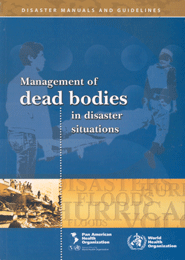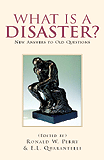|
|

|
These publications may be of interest to our readers. ADPC's Information
and Knowledge Management Unit can offer assistance in locating them.
After the Tsunami: UNEP's Rapid
Environmental Assessment Report. United Nations Environment Programme,
2005, ISBN 9-2807-2565-3, US$20.00. Order online at
www.earthprint.com or write to
orders@earthprint.com
The destruction caused to the environment by the Asian tsunami offers an
opportunity to rebuild in a manner that preserves natural resources for the
benefit of the local communities who were hardest hit. This report is based
on surveys by UNEP teams in the field working with other UN agencies,
governments and non-governmental organizations in the affected tsunami
regions. It looks at how regions are rebuilding and how future tragedies can
be avoided by adequate planning. The report covers topics such as waste,
water supply, sanitation and soil fertility, coral reefs, mangroves,
wildlife, beach erosion and coastal vegetation.
Know Risk. United Nations International Strategy for Disaster
Reduction, 2005, ISBN 9-2113-2024-0, UN Sales Number E.04.III.M.1, Tudor
Rose, US$125. Order online at
www.know-risk.org or contact Know Risk, Tudor Rose, Tudor House, 6 Friar
Lane, Leicester, LE1 5RA, UK, Tel: +44(0) 116 2229900, Fax: +44(0) 116
2229901
Know Risk is a fully illustrated publication with contributions from over
160 authors relating their work in disaster reduction at international,
regional, national, municipal and local levels. Commentaries under 15
sections cover a range of themes and issues such as, governance,
institutional policy, risk identification and assessment, information,
knowledge and experience, habitats in different areas, disaster preparedness
and contingency planning, international and regional support and future
directions. This commemorative publication reflects over ten years of
progress in this field, highlighting good practices and drawing on the ISDR
coordinated review of the Yokohama Strategy and Plan of Action for a Safer
World (1994). It emphasizes the benefits of experience leading to future
actions and institutional commitments to disaster reduction.
Mainstreaming Gender in Environmental Assessment and Early Warning.
United Nations Environment Programme, 2005, ISBN 9-2807-2487-6, 82 pp,
US$25.00. Order online at
www.earthprint.com or send an email to
orders@earthprint.com
This report seeks to understand key questions relating to gender
mainstreaming in UNEP's early warning and assessment program. It contains
reviews of the current situation and provides recommendations. It also
analyses key issues in the areas of gender and the environment as they
relate to water, poverty, security, conflict, early warning, disaster and
vulnerability to environment change.
 Management
of Dead Bodies in Disaster Situations. Pan American Health Organization,
2004, ISBN 9-2751-2529-5, 203 pp. US$28.00/20.00 (only for Latin America and
the Caribbean). Order code: OP 164
http://publications.paho.org or via email to: Ms Mylena Pinzon
pinzonmi@paho.org Management
of Dead Bodies in Disaster Situations. Pan American Health Organization,
2004, ISBN 9-2751-2529-5, 203 pp. US$28.00/20.00 (only for Latin America and
the Caribbean). Order code: OP 164
http://publications.paho.org or via email to: Ms Mylena Pinzon
pinzonmi@paho.org
This timely and useful manual from the Pan American Health Organization
provides technical information needed to support State authorities in the
proper management of bodies. This manual will be of interest to specialists
in disasters and in the management of human remains, and especially national
or local authorities who are responsible for ensuring that bodies are
treated in a dignified manner and that the human rights of those affected by
disasters are respected.
Developing Tsunami-Resilient Communities. The National Tsunami
Hazard Mitigation Program, Bernard, E.N. (Ed.), March 2005, ISBN:
1-4020-3353-2, Springer, VI, 186 p., Euro 77.00 (prepublication price).
Order online at:
http://www.springeronline.com/sgw/cda/frontpage/0,11855,5-40109-22-45854857-0,00.html
Tsunamis remain an ever-present threat to lives and property along the
coasts of most of the world’s oceans. Because of the geographical extent of
U.S. coastlines, an earthquake in Alaska can generate a local tsunami for
Alaskans and, hours later, a distant tsunami for communities in Hawaii
and along the Pacific Coast . This volume chronicles the development and
accomplishments of a joint State/Federal partnership that was forged to
reduce tsunami hazards along U.S. coastlines – the National Tsunami Hazard
Mitigation Program. By integrating hazard assessment, warning guidance, and
mitigation activities, the program has created a roadmap and a set of tools
to develop communities more resilient to local and distant tsunamis. Among
the set of tools are tsunami forecasting, educational experiments, early
alerting systems, and design guidance for tsunami-resilient communities.
 What
is a Disaster? New Answers to Old Questions. R.W. Perry and E.L.
Quarantelli, Editors2005, 442 Pages. Hardback ISBN 1-4134-7986-3 . US
$34.99. Paperback ISBN 1-4134-7985-5. US $24.99 plus shipping costs. From
Xlibris Publishers, International Plaza II, Suite 340, Philadelphia, PA
19113 USA, phone +1-888-795-4274.
Orders@Xlibris.com 10% discount on orders through Xlibris. What
is a Disaster? New Answers to Old Questions. R.W. Perry and E.L.
Quarantelli, Editors2005, 442 Pages. Hardback ISBN 1-4134-7986-3 . US
$34.99. Paperback ISBN 1-4134-7985-5. US $24.99 plus shipping costs. From
Xlibris Publishers, International Plaza II, Suite 340, Philadelphia, PA
19113 USA, phone +1-888-795-4274.
Orders@Xlibris.com 10% discount on orders through Xlibris.
This volume addresses the most basic question in the field: that of defining
the phenomenon of study. It brings together twelve social scientists
representing eight disciplines and seven countries to share their definition
and vision of disasters. In the process, a wide range of views are expressed
and issues raised regarding the relationship of academic versus practical
definitions, the impact of grouping types of disasters in different ways,
and the epistemologies on which theoretical growth should rest. The forum
provided involves the presentation of each author’s views, followed by a
discussant’s critique, and closed with a response from the author. The
editor’s close the volume with discussions of the theoretical framework of
disaster research and an agenda for disaster research in the twenty-first
century.
|

